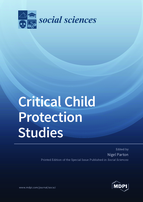Critical Child Protection Studies
A special issue of Social Sciences (ISSN 2076-0760). This special issue belongs to the section "Childhood and Youth Studies".
Deadline for manuscript submissions: closed (30 April 2022) | Viewed by 35729
Special Issue Editor
Interests: social problems and social welfare; child protection and child welfare; social work; social policy
Special Issues, Collections and Topics in MDPI journals
Special Issue Information
Dear Colleagues,
Until the last few years of the twentieth century, there was very little critical analysis of child protection policies and practices. Child protection was embedded in discussions about what to do about child abuse—it was constituted as the technical, administrative and legal response to the problem of child abuse. The core assumption was that it was concerns about child abuse and neglect which provided the rationale and focus for child protection policies and practices. The two were seen as inseparable and inherently intertwined.
However, in recent years, the study of child protection has undergone something of a transformation and is increasingly seen as an important area for study in its own right. Rather than see ideas about child abuse as being the determining factor in explaining the nature and purposes of child protection, a number of studies have begun to look at the shape and effects of child protection in a rather more critical and analytical light, including how policies and practices were themselves invented. What has become increasingly evident is that child protection policies and practices cannot be understood simply as responses to the phenomena of child abuse and neglect. They have their own dynamics and determinations to the point where, increasingly, they seem to operate quite independently of the social problem which, it is assumed, they are trying to prevent and respond to. A whole range of political, cultural, and sociological influences come to bear on the development and operation of child protection policies, practices, and systems.
The overall rationale for this Special Issue is that it is important to explicitly recognize the importance of critically studying child protection in its own right and that ‘child protection studies’ should be identified as an emerging and distinct interdisciplinary social science ‘field of study’. Up until this point, such a development has been incremental, with much of the work involving detailed and significant empirical work. More recently, however, we can detect developments of a more comparative, conceptual, and theoretical nature. Researchers from a range of academic disciplines have been involved, including those from anthropology, criminology, health, penology, politics, psychology, social policy, social work, and sociolegal studies.
The overall aim of this Special Issue is to provide a range of cutting-edge analyses of child protection. It will include papers which will advance theoretical, conceptual, and empirical understanding of how policies and practices operate and can be progressively and constructively reformed in a rapidly changing world. The Special Issue will be international in focus and will aim to include papers from a wide range of international academics and researchers. In the process, it will aim to establish ‘child protection studies’ as a distinct field of study.
It is anticipated that papers will address some of the following:
- The emergence and key elements of what makes up child protection;
- Historical studies of child protection;
- Comparative studies of child protection;
- Detailed analyses of different child protection systems in the form of case studies;
- The impact and implications of child protection policies for different sectors of society in terms of social class, race, gender, indigenous peoples, ability;
- Different approaches and orientations to child protection and their impact, including differential approaches, public health models, universal services, community, and user-based services;
- Key elements and questions to be addressed by a ‘child protection field of study’.
Emeritus Prof. Nigel Parton
Guest Editor






